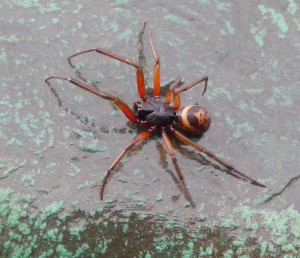
Well, it was certainly a large and striking spider with a distinctive crescent mark on the forward slope of its abdomen, so “False Widow Spider?” sprang into my mind. It was, amusingly, making itself conspicuous on the noble bronze surface of the Henry Moore statue in Kew Gardens: there’s just one now, reminding old-timers of the ‘one behind every bush’ feeling we had in 2006 when the gardens were full of Henry Moores, and I confess I pretty much ‘understood’ what they were about for the first time, seeing them against a natural (well, you know what I mean) background as massive, handsomely curved figures. One was near a splendidly branchy conifer, its huge curved branches setting off the sculpture.
But I digress. The spider had a finely moulded cephalothorax and a large, nearly globular abdomen, marked with a sandy crescent and a dotted area. Its legs were distinctively reddish. Back at home, I looked up images of false widows. It certainly wasn’t the large native False Widow, Steatoda bipunctata. It looked much like the introduced Steatoda nobilis; perhaps the dotted area on the abdomen was not typical, but it seems close enough. The species, according to the Natural History Museum, arrived here in the 1870s — not quite such a new arrival as the ebola-panicky tabloid newspapers seem to think, then. It most likely arrived among bananas from Madeira and the Canary Islands, so it really is a subtropical scary. It can “live comfortably in our homes all year round”, says the museum cheerily, and is now common and widespread. And yes, it does bite; but the effect is not much worse than a wasp sting. I suspect a bit of hydrocortisone cream would sort it out nicely. Or a swift tap with a shoe, of course.
